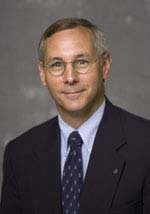Evaluation and Repair of Steel Bridge Structures with Fatigue Induced Damage
Mark D. Bowman
School of Civil Engineering
Purdue University
Abstract
Steel bridge structures are commonly used throughout the United States. Many of these structures have been in service for more than fifty years, and some of these structures are showing signs of distress through fatigue cracks that have developed. The initiation of a fatigue crack, while undesirable, does not necessarily mean that the bridge is beyond repair, and retrofit or repair measures to extend the useful service life of the bridge should be implemented if it is economically and operationally desirable. However, reliable information is needed to both evaluate the extent of the fatigue damage that has occurred and to subsequently recommend an effective repair. An experimental study was recently completed to explore the fatigue resistance of two different bridge details that are commonly encountered: tack welds left in place on primary or secondary members and details susceptible to distortion-induced cracking. The results of the study indicate that the fatigue resistance of members with tack welds may be greater than previously believed and often may not need to be retrofitted, while the behavior of details subjected to distortion-induced cracking are difficult to evaluate but can often be effectively repaired by using a stiffening detail that reduces the out-of-plane distortion.
Bio

Mark D. Bowman, Professor of Civil Engineering, Purdue University, has been a member of the Structural Engineering faculty for thirty-two years. He has BSCE and MSCE degrees from Purdue University and a PhD from the University of Illinois at Urbana-Champaign. Prior to his doctoral studies, Dr. Bowman worked as a structural design engineer for Precast/Schokbeton, Inc. in Kalamazoo, Michigan for two years. His research and refereed publications are primarily in the areas of steel design, fatigue and fracture, bridge engineering, and the behavior of structural connections. He has taught several courses on both structural analysis and the design of steel structures, and he has been involved in a lead role in the development and teaching of the Bridge Engineering class at Purdue for the last se veral years. He has been active in conducting several research projects for the INDOT, FHWA, NCHRP, NSF, Pankow Foundation, and other agencies over a broad range of different topics. These research projects range from laboratory experimental testing of individual members to field monitoring and structural evaluation of full bridge structures. Dr. Bowman has been active in technical committees in the American Society of Civil Engineers, the American Institute of Steel Construction, American Welding Society, the American Railway Engineering and Maintenance-of-Way Association, and the Transportation Research Board. At Purdue, he is presently serving as the Director of the Bowen Laboratory and as a member of the University Residence Review Committee.